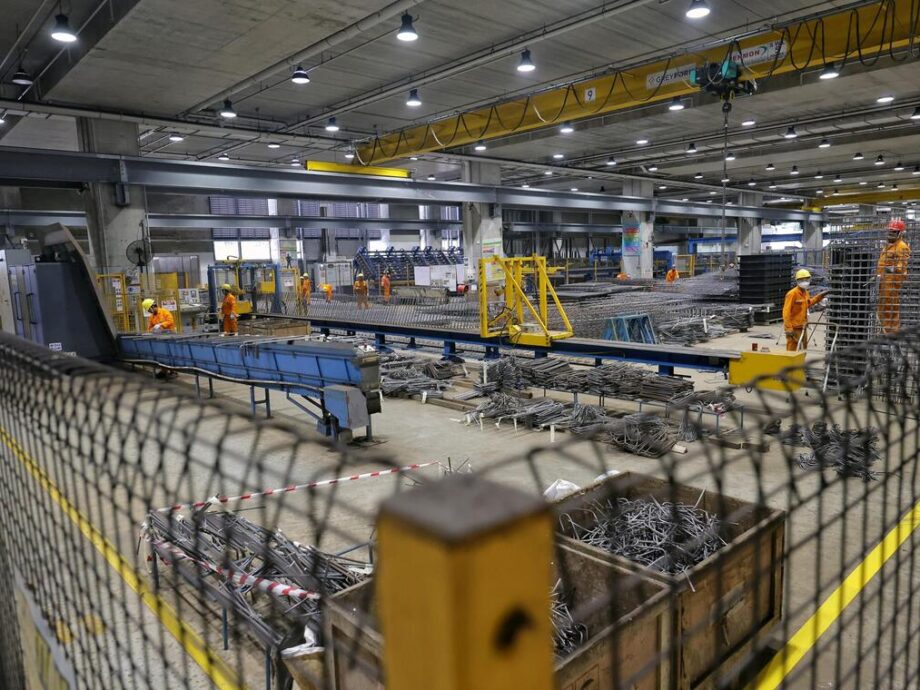Singapore’s precast puzzle: fast factories, slow projects
On some weeks in an industrial estate, a public road in Singapore turns into an unofficial storage yard. Trailers carrying concrete walls, slabs and bathroom pods sit in rows, waiting for job sites that are not ready to receive them. The loads come from an integrated construction and prefabrication hub, or ICPH, where building components are cast indoors by automated systems and prepared for just in time delivery. When those deliveries slip, factories face a simple and costly dilemma. Hold stock inside and choke the production line, or leave finished units on the roadside and risk fines. The scene captures a larger contradiction. Singapore invested in high tech plants to speed up building, yet the factories struggle when projects slow down.
- Singapore’s precast puzzle: fast factories, slow projects
- What is an ICPH and how it changes construction
- Storage gridlock and delivery bottlenecks
- Price pressure from across the border
- Policy shifts reshape demand
- PPVC investments and the sunk cost problem
- Government support and industry economics
- How peers are industrialising housing
- What could make ICPHs work
- Sustainability and resilience
- The Bottom Line
ICPHs are multi storey facilities that bring design for manufacturing and assembly into the concrete world. They produce 2D elements such as walls and floor slabs, as well as 3D modules like bathrooms and fully finished rooms. Compared with open precast yards where workers pour concrete in outdoor moulds, ICPHs can run faster and with fewer workers because many steps are automated. Even so, the model is under strain. Only six ICPHs have been built, short of a decade old target to reach ten by 2020. One site in Kaki Bukit sat vacant for an extended period after two operators were wound up, before a new operator was appointed in 2025. Public tenders for new hubs drew no bids when they closed in 2020, a moment that coincided with pandemic uncertainty and a pause in capital spending.
Profitability is the core problem. Operators say 2024 output was 20 percent to 50 percent below capacity for parts of the year. Construction delays, from weather to site constraints, mean factories cannot dispatch on schedule. Finished stock quickly eats up scarce storage space, so managers throttle production for a month or two until sites catch up. A line built to deliver high throughput becomes a start stop operation. Executives who once expected quick paybacks now talk about very long horizons, limited by 30 year land leases and cycles they do not control.
What is an ICPH and how it changes construction
ICPHs turn building into a sequence of controlled industrial steps. The approach, known locally as design for manufacturing and assembly, shifts work off site into factories that specialise in repetitive tasks. In practice that means precise digital models, standardized moulds, automated reinforcement cages, robotic or semi automated concrete casting, curing in controlled conditions and quality checks before shipping. On site, crews lift ready made parts into position and connect them. The pitch is compelling. Better quality and safer sites. Shorter build times. Much less rework. Fewer workers amid tight labour markets. HDB has reported man hour savings of up to 2.5 times for some precast processes, such as floor slabs, where automation reduces human error and boosts consistency.
How automated precast works
Design teams first lock in dimensions and joints so the factory can prepare moulds and reinforcement. Machines bend and place rebar. Automated beds pour concrete to tight tolerances. Temperature and humidity are controlled during curing to minimize defects. Elements are stripped, finished and marked with unique identifiers. Tracking tools such as RFID or Bluetooth tags follow each piece from casting to installation. The result is a production line that behaves more like manufacturing than conventional construction.
Why factories still idle
These benefits depend on flow. Unlike open yards with room to stack parts outdoors, ICPHs sit on tight footprints and need to keep stock moving. When a site falls behind, the factory cannot simply produce and pile up components. Even short interruptions echo through the line. Storing finished modules on public roads is cheaper than shutting the plant, yet it adds risk and erodes public goodwill. The better fix is tighter alignment of site schedules, logistics and production cycles, supported by shared storage and digital coordination.
Storage gridlock and delivery bottlenecks
Delays are common in dense cities. Heavy rain, design changes, utilities conflicts or manpower shortages can push back a floor cycle. For a factory, that means a day’s worth of walls and slabs has no place to go. Storage inside fills quickly. The Building and Construction Authority has tried to bridge the gap by allocating temporary occupation licence plots for overflow storage, usually for up to three years. These help, but they are a patch on a structural issue. Closer coordination between project teams and factories is needed so products leave the plant only when the site is actually ready.
Lim Han Ren, group chief executive of Soilbuild Construction Group, has operated an ICPH in Paya Lebar and tracked the gap between expected throughput and what the market has allowed so far. He reflected on how the productivity promise depends on site readiness and sustained demand.
“The reality is that this future as we see it takes a longer time to materialise than we thought.”
He said the hub averaged about 30,000 cubic metres of output in the past two years, roughly one quarter below its capacity. That shortfall erodes economies of scale. Measures that share storage, smooth site acceptance and digitise delivery slots could lift utilisation and improve the business case.
Price pressure from across the border
Malaysia’s conventional precast yards enjoy more land and lower costs. They can price concrete components roughly 15 percent to 20 percent below Singapore ICPHs. Some Singapore based precasters keep a small local yard to qualify as approved suppliers while producing most volume in larger Malaysian facilities. That arrangement helps them compete on price at home and across the region, yet it adds stress for ICPHs with higher fixed costs and less storage.
Higher land and labour expenses in Singapore are a known fact of doing business. The difference now is the capital intensity of automated hubs. Equipment, buildings and software are expensive. Depreciation does not pause when deliveries slow. In a market where lower cost imports are available, price competition can move orders across the border and leave local lines underused.
Policy shifts reshape demand
Rules on local sourcing have shifted over the past three years. A move in early 2022 had required a larger portion of key precast elements in public housing to be sourced locally. That approach changed in April 2024 to give contractors more flexibility to draw from both local and foreign plants. The Housing and Development Board plans to launch about 55,000 build to order flats from 2025 to 2027. The agency said that with local factories sometimes running near optimum, it needs multiple supply channels to meet peak periods without compromising timelines.
HDB also reviewed the economics of prefabricated prefinished volumetric construction, the 3D module approach often used for rooms and bathrooms. It explained why most recent projects have shifted to Advanced Precast Concrete System with mainly 2D components.
“The overall costs for PPVC projects piloted by HDB were, on average, as much as 20 percent higher than APCS projects primarily built using 2D components, due to factors such as production, storage and transport.”
The shift reduced orders for 3D modules and made some PPVC focused investments harder to justify. Industry leaders add that the supply chain for 2D elements is more resilient because moulds are cheaper and faster to replicate in a surge.
PPVC investments and the sunk cost problem
3D modules can weigh 25 to 40 tonnes. Plants configured for them bought larger gantry cranes, often around S$250,000 each, and built structures with higher floor to ceiling clearance to support heavy lifts. Those choices made sense when PPVC demand was rising. When the mix moved back toward 2D, equipment and building characteristics became mismatched to the market. That is less a failure of technology than a reminder that factory design must track the product roadmap of major buyers.
Some managers still see a route to reliable returns if public and private buyers converge on common parts. Kevin Soh, director at Integrated Precast Solutions, argues that standardisation on the demand side unlocks the efficiency of automation on the supply side.
“Further standardising the design of precast components will allow automated technologies to be tapped more efficiently, since the moulds and processes used to produce them can be kept more constant.”
Soh and others also recommend longer leases for ICPHs to spread capital costs across a longer period. That change would reflect the lost production during the pandemic years when construction was disrupted.
Government support and industry economics
The Building and Construction Authority has used several instruments to spur adoption. The Productivity Innovation Project co funded up to 70 percent of qualifying technology costs, capped at S$10 million for solutions that deliver at least a 40 percent productivity gain in a process. That scheme has ended and is now replaced by the Built Environment Technology and Capability Grant. Tax incentives help too. The Land Intensification Allowance was extended to ICPHs in 2017 and renewed at Budget 2025 to run until end 2030. Only one ICPH has used the allowance so far, in part because most hubs were developed before 2017 and could not benefit from it.
A BCA spokesperson summed up both the commercial reality and the agency’s role in smoothing planning for operators.
“The financial viability of ICPHs depends on various factors, including their market positioning, product offerings and pricing strategies. BCA will continue working with key procurers such as HDB to provide ICPH operators with visibility of upcoming precast demand and specific product requirements.”
There are examples of resilience. Tiong Seng Prefab Hub, which opened in 2012, was developed outside the later BCA land tender programme and cost about S$36 million. The operator says the facility has kept service consistent across major projects even as profits rose and fell with market cycles. The case suggests automated hubs can sustain a role when product mix and demand are stable.
How peers are industrialising housing
Comparative research on modular construction in mainland China, Hong Kong and Singapore highlights common ground. Modular and precast methods reduce construction time and raise quality. The challenges are also familiar. Upfront costs are higher than traditional building, preparation takes longer, and technical standards lag the pace of innovation. Success depends on clear specifications, supportive policies and close coordination between public buyers, contractors and factories.
India’s recent push offers another lens. The Global Housing Technology Challenge set up six light house projects that test a range of methods at scale, including 2D precast, 3D volumetric modules, tunnel form and composite systems. The idea is to demonstrate speed and quality in live projects and accelerate the shift from pilot to widespread adoption. These programmes show how public procurement can curate demand, set expectations and reduce risk for innovators.
What could make ICPHs work
Standardisation ranks top on the industry’s wish list. If HDB and private developers agree on a tighter catalogue of walls, slabs, facades and bathroom units, factories can run longer batches, reuse moulds more often and cut changeover time. HDB and BCA have started with prefabricated bathroom units and household shelters. A broader template set could push automated lines closer to rated output, improving costs and reliability.
Lease terms shape risk. Most ICPHs sit on 30 year leases. Extending tenure would lower annual capital charges and make financing easier, especially for facilities that faced extended disruptions during the pandemic. That lever requires no operating subsidy and directly addresses the fixed cost side of the equation.
A level playing field with conventional yards would help too. Rules on local presence and imported precast should support supply security without tilting volume away from Singapore when local factories have spare capacity. Transparent pipelines of public sector demand, with product specifications released early, will also aid investment decisions.
Logistics and site readiness are just as vital as factory speed. The tools already exist. Integrated digital delivery connects design models, shop drawings, manufacturing steps and site plans on one platform. RFID or Bluetooth tags track components, improving scheduling, acceptance and warranty records. HDB has tested AI aided crane path planning, anti collision systems and devices that orientate panels before installation to reduce manual handling. When applied together, these measures smooth the flow from mould to installation. Factories spend less time idling with finished stock and more time making what the site can receive.
Sustainability and resilience
Precast methods can cut waste and support cleaner construction. Factory production reduces material spillage and improves curing, which lowers rework and defects. Research on sustainable construction materials derived from waste streams points to new blends that can reduce carbon intensity while maintaining strength and durability. Because precast plants control mix designs and quality, they are well positioned to trial and scale such materials.
The long term direction of Singapore’s built environment is clear. The city wants to build faster, safer and with fewer workers. HDB targets a 40 percent improvement in site productivity by 2030. Automated precast, backed by standardised products and digital coordination, can carry much of that load. The system will still need flexibility to import during peaks, but a robust base of competitive local factories strengthens resilience when supply chains are stressed.
The Bottom Line
- Six ICPHs operate in Singapore, below the original goal of ten by 2020, and one site needed a new operator after a long vacancy.
- Output at many hubs ran 20 percent to 50 percent below capacity in 2024 as project delays caused storage logjams and forced production pauses.
- Malaysian open yards price precast 15 percent to 20 percent lower, helped by cheaper land and more storage, pressuring margins at Singapore ICPHs.
- HDB has shifted most projects from 3D PPVC to 2D APCS after finding PPVC costs up to 20 percent higher on average.
- Government support includes grants for technology adoption and a land tax allowance extended to 2030, while BCA works to provide operators with demand visibility.
- Industry proposals focus on wider standardisation of components, longer lease terms for hubs, and better logistics through digital tools and shared storage.
- Automation still delivers quality and man hour gains, and a stable, standardised pipeline could restore factory economics and resilience.




